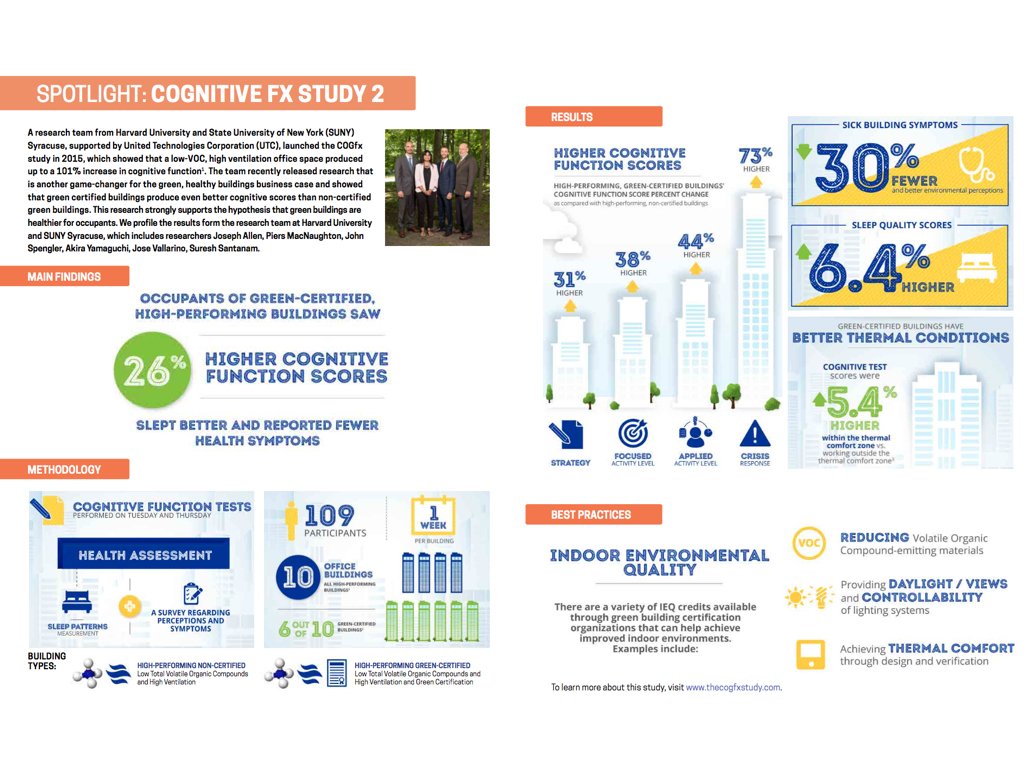healthy buildings vs sick building syndrome
What are the cognitive health benefits of green healthy buildings?
Source: THE COGFX STUDY https://thecogfxstudy.com/study-1/
What is Sick Building Syndrome?
Unexplained feelings of fatigue, irritated eyes, runny nose, sore throat or headaches when spending long days in an office or home can be signs of an unhealthy indoor environment.
Although the immediate symptoms may be deemed ‘light’, the long-term effects can include respiratory disease, cardiovascular disease and lung cancer.
This is the story of Sick Building Syndrome (SBS) and how its counterpart, healthy buildings, are fighting back in the post-Covid era.
Indoor Environmental Quality (IEQ)
Leaving aside any external factors such as lack of sleep, any existing ailments, poor nutrition, low level dehydration, or simply a hangover (!), indoor environmental quality (IEQ) has a tangible impact on our energy levels, cognitive function, and overall wellbeing yet, pre-Covid at least, was largely overlooked outside of certain progressive workplaces.
For more on this, see the Harvard Cognitive FX study on IEQ in green buildings, where IEQ is defined as being made up of - reduced levels of Volatile Organic Compounds, access to daylighting and views, smart lighting systems, and thermal comfort.
IEQ is suddenly top of the agenda in the form of enhanced indoor ventilation, air purification strategies, healthy interior materials and enhanced cleaning protocols.
Its sub-group, Indoor Air Quality (IAQ), is focused specifically on measuring indoor air to monitor occupant exposure to Carbon Monoxide (CO), Carbon iodide (CO2), Nitrogen Dioxide (NO2), Ozone (O3) and Fine Particulate Matter (dust).
Healthy materials
The main source of circulating interior toxins come from what we can loosely call ‘unhealthy’ materials, i.e. those that off-gas chemical toxins into the air during their lifecycle, which to be clear, can mean during the production phase, the in-use phase and the end-of-life phase!
That new paint or furniture smell isn’t a good sign in other words, especially as the after-effects can linger for months if not years due to steady erosion (friction and wear) during the use phase, photo degradation from sunlight and volatilization (natural degradation off-gassing).
VOCs chemical off-gasses
These chemicals can then be inhaled, absorbed via the skin or ingested by building occupants. Much of this can go unnoticed of course… until it doesn’t. The eventual health impact depends on the dose, frequency and duration of the exposure to such chemicals as well as each occupant’s personal genetic make-up and health condition.
Health risks in building interiors
Chemicals brought into interiors can be asthmagens, carcinogens and hormonal disruptors, so the risk is not to be taken lightly. And that’s before considering issues such as mold, flame retardants (found in old furniture) and pesticides, as well as outdated building materials such as asbestos or lead paint, even certain type of nail polish and perfumes will negatively impact indoor air quality.
This should not be the case in a brand new skyscraper but remains all too common in the affordable housing sector for example - think of how peeling paint and poor maintenance in an old building originally constructed using low grade materials could compound over time to create a severe case of Sick Building Syndrome for occupants
Common toxins to avoid in building materials and products
Unhealthy materials and toxic chemicals can be found in many different interior sources. Most commonly in insulation materials, paints and coatings, adhesives, furniture and fabrics, flooring and ceiling panels.
Although there are many different toxins that reside in building materials, some of the most common include VOCs (Volatile Organic Compounds), SVOCs (Semi-volatile Organic Compounds), Lead and HFRs (Halogenated flame retardants).
Healthy building glossary
VOCs (Volatile Organic Compounds) and SVOCs (Semi-volatile Organic Compounds) become gaseous at room temperature, can be ingested or inhaled, and pose health risks even with minimal amounts of chemicals.
Lead is most commonly found in paints and can impair cognitive function—a trait that is especially dangerous for young children.
HFRs are commonly ingested through dust particles, inhaled or skin contact and can be found in furnishings and electrical devices.
